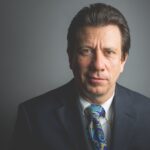Mind, Body… and Something: How to Teach Spirituality in a Naturopathic Curriculum?
FRASER SMITH, MATD, ND
Spirituality has many definitions. But whether it has a common definition or not, many of us in the profession believe the spiritual dimension of a person is an important aspect of health. The vast human experience with this aspect of our nature, as well as the many ways in which it has been described, make it somewhat challenging to present in a lecture. The very personal and sometimes-private practice of spirituality and attended beliefs can make naturopathic interns shy away from broaching the subject. That might sometimes be wise in certain patient-visit situations, but not as long-term practice. This month we’ll look at some of the challenges and the wonderful resources that can assist us in training students to truly embrace an approach that is body, mind, and spirit.
There are 2 things of which I have never had to worry about interns being in short supply. One is some very broad knowledge of therapeutic, specialty, and popular diets; patients and students can always be counted on to round out my own reading on the ever-shifting North American diet industry. The other is some intrinsic, and almost instinctive, sense of how to be with a patient and allow them to open up and share their hopes, fears, doubts, and conflicts. Yes, there are some students who need more training and coaching in this at first, and always a few who like to stick to more tangible issues with their patients. But for the most part, I’ve observed that naturopathic interns can really relate to their patients, and many of their patients come to trust them and often bond with them in a remarkably short time. Perhaps that is why we can get by with claiming to be “body, mind, & spirit” when the spiritual can be the trickiest to present as education in a program where science, respect for individual beliefs and practices, and reliable learning outcomes comprise the educational dashboard.
Part of the problem is the rather stark separation of mind/spirit from body/neurochemistry in Western medicine. This arose out of a drive to explain disease and its cures on a rational basis and to use the scientific process to slowly accrue knowledge. This is not a bad thing in itself. The problem is that clinical medicine involves working with human beings, which includes their self, their personhood, their beliefs, and their inner experience. These might shrink in relevance in emergency situations where an event occurs in seconds and a reliable and fast treatment is required to save a life. But in the long haul of illness, chronic illness, and even terminal illness, these verities of our existence rise back to the surface.
A Spiritual Break from Reductionism
As the 20th century unfolded, physicians, nurses, therapists, and researchers began to reintroduce concepts of mind and spirit as a much-needed extension to the prevailing reductionistic model. This is very much in line with the dynamic dualism of “Empirical” and “Rationalist” approaches. Some of the approaches, such as creating models for working with dying patients who have spiritual needs, are very much in the whole-person category. Others, such as psycho-neuro-immunology – which, among other phenomena, has studied the relationship between hope and immune function1 – use more of a scientific (biomedical) methodology rather than a social science (quantitative and qualitative) research approach. These have all been valuable advances in their own way. At the risk of leaving out many important contributors, physicians such as Bernie Siegel,2 with his books such as Love, Medicine, & Miracles and Peace, Love, and Healing, brought this issue further into the public consciousness. Here was a cancer surgeon, using the most modern methods, but giving case history after case history of how people’s lives were dramatically altered by finding a connection with an inner consciousness of the sacred. Sometimes that involved inexplicable healing, or a resolve to endure a painful series of treatments and defy a prognosis, or a quiet and serene acceptance (stages of grief notwithstanding) of the dying process.
Spirituality in Education
The popular and indexed scientific literature is a good place to start in naturopathic education. The goal is discussion, and the subject matter can be presented in class in a way that does not push any particular belief system on a student. From personal experience, I can say that this has to be done with care. Some students might feel that talking about the divine is too “new age” and smacks of the self-help books that fill the search pages of Amazon. Other might find it “woo-woo” and ask why they have to discuss something ineffable in a scientifically informed program of studies. Sampling or mentioning religious practices can be done in a rotational fashion, but again, getting it wrong – or a class discussion veering toward a critique – could end rather poorly. Although our naturopathic colleges are higher-education institutions and we try to practice tolerance of different viewpoints, these are students who are rapidly acquiring physician-level skills, and that super-ordinate goal has to be kept in mind. A battle of world views might be scintillating in a Masters program in religious studies; however, in a cohort that has to be together in medical training every day for 4 years, it is not wise.
Not only is the indexed literature a good common ground; it is also a great orientation for students to look at this issue from an evidenced-based perspective. I find that most naturopathic students already have a deep appreciation for the role of mind and spirit in healing. If they have personally been through a major health crisis prior to (or during!) medical school, their appreciation will be even deeper. But there is a lot to discuss in the research on this topic.
This research includes questions such as:
- Do prayer, meditation, or spiritual beliefs influence outcomes in a particular patient population?
- Do immune parameters or cortisol levels change due to these practices?
- How do we define the concept of spirituality?
- Is there a brain basis for some of these experiences?
- Are these phenomena too general and inward to actually study on an empirical basis?
- What are the best practices for physicians in taking a history and giving advice?
An Abundance of Tools
As students progress in the program and start learning how to do a patient intake, there are opportunities to incorporate topics of spirituality into their training. A surprising amount of research, literature, and tools exist that support taking a “spiritual history.” An example is Reed’s Spiritual Perspective Scale, developed in 1986. Research on the Multidimensional Measure of Religiousness/Spirituality (MMRS) was published by the National Institute of Aging in 2011.3 There are well over 20 such instruments. Some focus on overall spiritual well-being. Others look at how beliefs and practices can be relied upon when a health crisis intervenes in a person’s life. Some are tailored to those recovering from alcoholism, addiction, etc.
One practical interviewing tool for taking a spiritual history – the HOPE model4 – originated at Brown University and is widely used. The questions in this model are simple to integrate into the flow of a patient intake. The letters in “HOPE” represent the following:
- H: Sources of hope, meaning, comfort, strength, peace, love and connection
- O: Organized religion
- P: Personal spirituality and practices
- E: Effects on medical care and end-of-life issues
A community of scholars and practitioners actively study this field. Harvard University has a translational science center that helped host a symposium in 2014 about spirituality and healing.5 Similar workshops, and full conferences, are educational events that faculty members and students can avail themselves of.
There are also psychological lines of research, such as transpersonal psychology,6 which started in the mid-20th century. The work of humanistic psychology pioneer, Abraham Maslow, was part of its foundation. The transpersonal psychology approach considers forces beyond just the subconscious. It studies what different states of consciousness and perspectives of reality have in common regardless of the specific practice that might lead a person there.6
As naturopathic students progress further into the program, it is helpful to discuss the nuances of using these different tools. Even with an organized approach, these topics must be approached with care. The importance of using discretion and a tactful savoir faire doesn’t mean that these matters have to be approached with trepidation. But rookie practitioners should work carefully and deliberately, with feedback from their clinical faculty in these matters of spiritual well-being.
The all-pervasive and vital “spirit” aspect of our being can easily be relegated to that “something” alluded to in the title of this month’s essay. The reasons for being vague or even evasive in discussing this subject are many, and sometimes well intentioned. We can take heart in the fact that at our colleges, these different facets are explored with our students. Teaching them this subject matter offers great clinical potential, simply on the basis of the naturopathic models of care and research that continue to develop. In a certain sense, it is an infinite potential. Helping our patients call on even a little of this untapped reservoir of hope, strength, and courage in terms of their own understanding is something we don’t want to miss out on.
Preparing Our Students
Students might be too brusque or too differential when discussing these topics with patients. They might approach a sensitive spiritual topic (eg, a patient’s crisis of meaning in their life, or difficulty accepting mortality) with the same nonchalant approach with which one might obtain a review of systems. Or, they might fail to pick up on a patient’s nonverbal or even verbal clues that the patient wishes to change the subject.
The progression of internship learning supports accumulated experience in making decisions about what to recommend to a patient. There are books, retreats, counselors, places of workshop, institutes, and more.
These opportunities for learning happen every day in our teaching clinics. Patients present with terminal illnesses. People’s lives seem to fall apart, often on the physical, relationship, and employment fronts, sometimes all in the same year. An intention to approach such patients with compassion, emotional intelligence, and common sense is often insufficient without a lot of didactic training related to spiritual matters. Sometimes, experience combined with wise guidance from a clinical preceptor is all a student needs to be on their way.
But with a commitment to preparing students as well as we can to obtain maximum benefit from their training, with the goal of being very prepared, we ought to continue to teach something about spiritual care. Given the depth of research and variety of practices on the spiritual dimension, there is also certainly plenty to talk about.
References:
- D’Acquisto F. Affective immunology: where emotions and the immune response converge. Dialogues Clin Neurosci. 2017;19(1):9-19.
- Bernie Siegel, MD. 2021. Available at: http://berniesiegelmd.com/. Accessed October 25, 2021.
- Monod S, Brennan M, Rochat E, et al. Instruments measuring spirituality in clinical research: a systematic review. J Gen Intern Med. 2011;26(11):1345-1357.
- UW Medicine. Department of Bioethics and Humanities. Spirituality and Medicine. 2018. Available at: https://depts.washington.edu/bhdept/ethics-medicine/bioethics-topics/detail/79. Accessed October 20, 2021.
- Barlow E. Spirituality and Healing: Harvard Catalyst symposium explores how spirituality and religion may both help and hinder health. January 14, 2015. Harvard Medical School Web site. https://hms.harvard.edu/news/spirituality-healing. Accessed October 24, 2021.
- Taylor S. Transpersonal Psychology: Exploring the farther reaches of human nature. September 25, 2015. Psychology Today Web site. https://www.psychologytoday.com/us/blog/out-the-darkness/201509/transpersonal-psychology. Accessed October 27, 2021.

Fraser Smith, MATD, ND is Assistant Dean of Naturopathic Medicine and Professor at the National University of Health Sciences (NUHS) in Lombard, IL. Prior to working at NUHS, he served as Dean of Naturopathic Medicine at the Canadian College of Naturopathic Medicine (CCNM) in Toronto, Ontario. Dr. Smith is a licensed naturopathic physician and graduate of CCNM.









